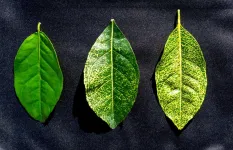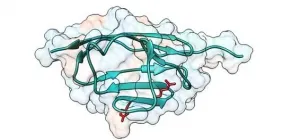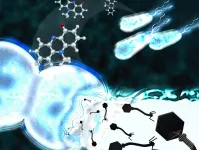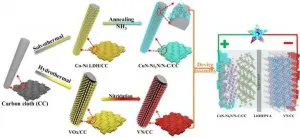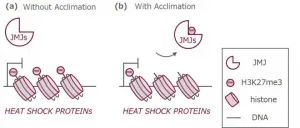(Press-News.org) Scientists are hoping the RNA of an obscure infection can one day be used like a Trojan horse to deliver life-saving treatments to citrus trees.
The infection, citrus yellow vein disease, was discovered 64 years ago in Riverside and has never been seen elsewhere in the world. Decades later, UC Riverside researchers have finally unraveled the associated pathogen's genetic codes -- a significant step toward harnessing its unique properties.
A paper describing this work was published recently in the journal Frontiers in Microbiology. It opens the door to testing whether this apparently benign infection could be used as a vehicle to transport antibacterial and antiviral agents into citrus plants' vascular systems, where infections usually take place.
Citrus crops face a highly uncertain future due to Huanglongbing, also known as citrus greening disease. In the past decade, the disease has caused a 72% decline in oranges used for juice, and a 21% decrease in the American fresh citrus fruit market. Growers in other parts of the world are similarly affected, and it continues to spread unabated.
Though there are promising treatments and disease-resistant hybrids being developed for Huanglongbing, none are yet commercially available.
Cells use RNA to convert the information stored in DNA into proteins that carry out different functions. Yellow vein disease is associated with small, independently mobile RNA, called iRNA, which spreads through a plant's vascular system. This spreading mechanism could be a new way to send treatments for Huanglongbing or other diseases into plants.
The story of this promising research starts in 1957 with Lewis Weathers, a UC Riverside plant pathology professor.
"He found four limequat trees with beautiful, bright veins on their leaves, almost fluorescent yellow," said Georgios Vidalakis, a plant pathology professor at UCR, UC-ANR cooperative extension specialist, and principal investigator on the new paper.
"That color was recognized as a disease, and samples of it were deposited at the Citrus Clonal Protection Program disease bank where it was waiting for us to study decades later," Vidalakis said.
Based on Weathers' experiments, it did not appear as though the disease is carried by any animal or other microorganism, Vidalakis said.
"We think it was introduced into the limequats in a single event, and once those plants were destroyed, it never spread to other citrus in California."
Researchers have learned, however, how the disease spread between cells in infected plants. The iRNA disguises itself with plant proteins that lets it pass through cellular connective tissue. This ability to travel inside citrus trees may allow the iRNA to send protective molecules into noncitrus plants as well, including grapes, olives, and cacao.
Yellow vein disease iRNA is also surprisingly small, even for a microscopic organism. Plant viruses typically have four to 10 genes on an average, each with at least one function. The iRNA of this disease has only one functional gene.
"The iRNA is amazing because it's able to manipulate plant cells to help it replicate, despite having only one functional gene," explained Kiran Gadhave, a UCR microbiologist, corresponding author of the paper, and lead researcher of the iRNA project. "In addition to its potential therapeutic value, it's just a scientific curiosity. This is as small as it gets."
Though they believe the pathogen to be benign, the research team is doing additional testing to make sure it won't affect fruit quality or quantity, tree height, or any other markers of health. Symptoms in greenhouse-grown trees were mild. Now this is being tested in a field trial in the living laboratory at the UCR Agricultural Experiment Station AgOps.
"The support of the Citrus Research Board and our close collaborations with the University of Maryland and Silvec Biologics are proving to be crucial in taking this technology from lab to the farm," Gadhave said.
One day, iRNA could be used alongside gene editing technologies like CRISPR, in which cells are trained to recognize and destroy nucleic acids from invading plant pathogens. There are challenges with both methods that need to be overcome first, like managing unintended effects, costs, and efficient delivery.
"The common limitations of both approaches can be overcome by matching their strengths, the same way we integrate different disease management solutions," Gadhave said.
INFORMATION:
Scientists at the Centro Nacional de Investigaciones Cardiovasculares (CNIC) have described a potential disease-causing mechanism in hypertrophic cardiomyopathy (HCM), the most frequent hereditary disease of the heart. The study, published in the journal ACS Nano, provides the first description of an association between this disease and mechanical alterations to a component of the contractile machinery of the heart.
The heart muscle is under constant mechanical stress throughout life as it contracts to pump blood to the body. The laboratory led by Dr. Jorge Alegre-Cebollada investigates how the mechanical properties of the cardiac proteins determine the physiological behavior of this muscle and how alterations to these properties lead to the appearance of diseases like ...
This targeted control of phages provides entirely new biotechnological and therapeutic approaches, e.g. for phage therapies. The results produced in the context of an ERC grant have been published in the Journal of the American Chemical Society.
The human body and its microbiota harbour a large amount of phages. These infect bacteria as virus particles to ensure their own survival. One of their strategies is to integrate into the bacterial genome and multiply via bacterial cell division. However, external signal molecules can trigger the phages' sudden awakening from their dormant ...
Imagine you're a fisherman living by a lake with a rowboat. Every day, you row out on the calm waters and life is good. But then your family grows, and you need more fish, so you go to the nearby river. Then, you realize you go farther and faster on the river. You can't take your little rowboat out there - it's not built for those currents. So, you learn everything you can about how rivers work and build a better boat. Life is good again...until you realize you need to go farther still, out on the ocean. But ocean rules are nothing like river rules. Now you have to learn how ocean currents work, and then ...
DARIEN, IL - Findings from a recent study show that patients with untreated, moderate to severe obstructive sleep apnea had a higher risk of experiencing a cardiovascular event, but the risk of incident heart problems was decreased in those who used CPAP therapy.
Results show that people with moderate to severe sleep apnea and no record of CPAP use were 71% more likely than those without sleep apnea to experience incident myocardial infarction, stroke, unstable angina, heart failure or cardiovascular death. Compared with the risk of heart problems in people with untreated sleep apnea, the risk of experiencing a cardiovascular event was 32% lower ...
ITHACA, N.Y. - The Noceto Vasca Votiva is a unique wood structure that was unearthed on a small hill in northern Italy in 2005. Built primarily of oak and slightly larger than a backyard swimming pool, the exact purpose of the in-ground structure has remained a mystery, as has the date of its construction. Italian researchers estimated its origins go back to the late Middle Bronze Age, sometime between 1600 and 1300 B.C.
While that gap might not seem huge, in archeological terms it's like comparing the culture that invented the steam engine with the one that produced the iPad.
A Cornell University team led by Sturt Manning, Distinguished ...
Fast radio bursts, or FRBs, blaze for a few milliseconds before vanishing without a trace. Their origins are unknown, and their appearance is unpredictable. In the decade following their discovery in 2007, only 140 FRBs had been seen. Now, thanks to the launch of a large stationary telescope in the interior of British Columbia in 2018, the number of new FRBs detected has almost quadrupled - for a total of 535. Moreover, the Canadian Hydrogen Intensity Mapping Experiment (CHIME/FRB), a McGill-led inter-university collaboration, has put together the first CHIME/FRB catalogue, which will be presented this week at the American Astronomical Society Meeting.
CHIME is unique in that ...
Recently, a research team led by Prof. ZHAO Bangchuan from the Institute of Solid Materials of the Hefei Institutes of Physical Science (HFIPS) synthesized 3D porous honeycomb-like CoN-Ni3N/N-C nanosheets and vanadium nitride (VN) nanobelt arrays via in-situ growth method, respectively, and constructed a high-energy-density flexible supercapacitor device. The result has been published in Advanced Functional Materials.
Transition metal nitrides (TMNs) are potential electrode materials for high-performance energy storage devices, but the structural instability severely hinders their application. Therefore ...
Ikoma, Japan - "If you can't stand the heat, get out of the kitchen," as the old saying goes. But for organisms that can't leave the proverbial kitchen when things get too hot, there's another way: researchers from Japan have discovered that plants can gain heat tolerance to better adapt to future heat stress, thanks to a particular mechanism for heat stress 'memory'.
In a study published in Nature Communications, researchers from Nara Institute of Science and Technology have revealed that a family of proteins that control small heat shock genes enables plants to 'remember' how to deal with heat stress.
Climate change, especially global warming, is a growing threat to agriculture ...
Prostate cancer is the most common form of cancer among Canadian men and the third leading cause of cancer death. Abdominal obesity appears to be associated with a greater risk of developing aggressive prostate cancer. This link was demonstrated in a END ...
Generally, physics and financial systems are not easily associated in people's minds. Yet, principles and techniques originating from physics can be very effective in describing the processes taking place on financial markets. Modeling financial systems as networks can greatly enhance our understanding of phenomena that are relevant not only to researchers in economics and other disciplines, but also to ordinary citizens, public agencies and governments. And the theory of Complex Networks represents a powerful framework for studying how shocks propagate in financial systems, identifying early-warning signals of forthcoming crises, and reconstructing ...
